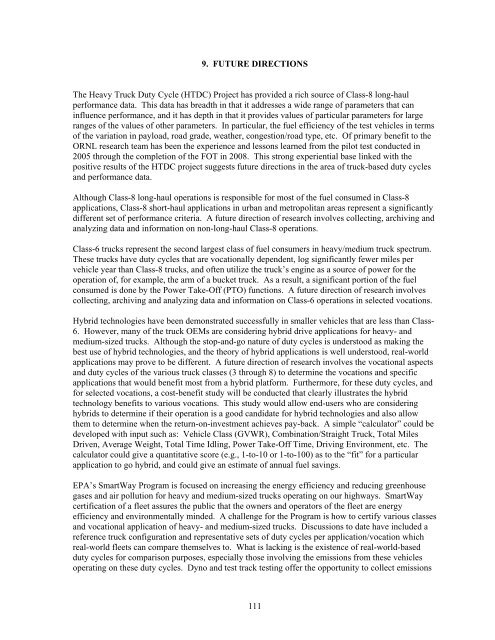Class-8 Heavy Truck Duty Cycle Project Final Report - Center for ...
Class-8 Heavy Truck Duty Cycle Project Final Report - Center for ...
Class-8 Heavy Truck Duty Cycle Project Final Report - Center for ...
Create successful ePaper yourself
Turn your PDF publications into a flip-book with our unique Google optimized e-Paper software.
9. FUTURE DIRECTIONS<br />
The <strong>Heavy</strong> <strong>Truck</strong> <strong>Duty</strong> <strong>Cycle</strong> (HTDC) <strong>Project</strong> has provided a rich source of <strong>Class</strong>-8 long-haul<br />
per<strong>for</strong>mance data. This data has breadth in that it addresses a wide range of parameters that can<br />
influence per<strong>for</strong>mance, and it has depth in that it provides values of particular parameters <strong>for</strong> large<br />
ranges of the values of other parameters. In particular, the fuel efficiency of the test vehicles in terms<br />
of the variation in payload, road grade, weather, congestion/road type, etc. Of primary benefit to the<br />
ORNL research team has been the experience and lessons learned from the pilot test conducted in<br />
2005 through the completion of the FOT in 2008. This strong experiential base linked with the<br />
positive results of the HTDC project suggests future directions in the area of truck-based duty cycles<br />
and per<strong>for</strong>mance data.<br />
Although <strong>Class</strong>-8 long-haul operations is responsible <strong>for</strong> most of the fuel consumed in <strong>Class</strong>-8<br />
applications, <strong>Class</strong>-8 short-haul applications in urban and metropolitan areas represent a significantly<br />
different set of per<strong>for</strong>mance criteria. A future direction of research involves collecting, archiving and<br />
analyzing data and in<strong>for</strong>mation on non-long-haul <strong>Class</strong>-8 operations.<br />
<strong>Class</strong>-6 trucks represent the second largest class of fuel consumers in heavy/medium truck spectrum.<br />
These trucks have duty cycles that are vocationally dependent, log significantly fewer miles per<br />
vehicle year than <strong>Class</strong>-8 trucks, and often utilize the truck’s engine as a source of power <strong>for</strong> the<br />
operation of, <strong>for</strong> example, the arm of a bucket truck. As a result, a significant portion of the fuel<br />
consumed is done by the Power Take-Off (PTO) functions. A future direction of research involves<br />
collecting, archiving and analyzing data and in<strong>for</strong>mation on <strong>Class</strong>-6 operations in selected vocations.<br />
Hybrid technologies have been demonstrated successfully in smaller vehicles that are less than <strong>Class</strong>-<br />
6. However, many of the truck OEMs are considering hybrid drive applications <strong>for</strong> heavy- and<br />
medium-sized trucks. Although the stop-and-go nature of duty cycles is understood as making the<br />
best use of hybrid technologies, and the theory of hybrid applications is well understood, real-world<br />
applications may prove to be different. A future direction of research involves the vocational aspects<br />
and duty cycles of the various truck classes (3 through 8) to determine the vocations and specific<br />
applications that would benefit most from a hybrid plat<strong>for</strong>m. Furthermore, <strong>for</strong> these duty cycles, and<br />
<strong>for</strong> selected vocations, a cost-benefit study will be conducted that clearly illustrates the hybrid<br />
technology benefits to various vocations. This study would allow end-users who are considering<br />
hybrids to determine if their operation is a good candidate <strong>for</strong> hybrid technologies and also allow<br />
them to determine when the return-on-investment achieves pay-back. A simple “calculator” could be<br />
developed with input such as: Vehicle <strong>Class</strong> (GVWR), Combination/Straight <strong>Truck</strong>, Total Miles<br />
Driven, Average Weight, Total Time Idling, Power Take-Off Time, Driving Environment, etc. The<br />
calculator could give a quantitative score (e.g., 1-to-10 or 1-to-100) as to the “fit” <strong>for</strong> a particular<br />
application to go hybrid, and could give an estimate of annual fuel savings.<br />
EPA’s SmartWay Program is focused on increasing the energy efficiency and reducing greenhouse<br />
gases and air pollution <strong>for</strong> heavy and medium-sized trucks operating on our highways. SmartWay<br />
certification of a fleet assures the public that the owners and operators of the fleet are energy<br />
efficiency and environmentally minded. A challenge <strong>for</strong> the Program is how to certify various classes<br />
and vocational application of heavy- and medium-sized trucks. Discussions to date have included a<br />
reference truck configuration and representative sets of duty cycles per application/vocation which<br />
real-world fleets can compare themselves to. What is lacking is the existence of real-world-based<br />
duty cycles <strong>for</strong> comparison purposes, especially those involving the emissions from these vehicles<br />
operating on these duty cycles. Dyno and test track testing offer the opportunity to collect emissions<br />
111
















